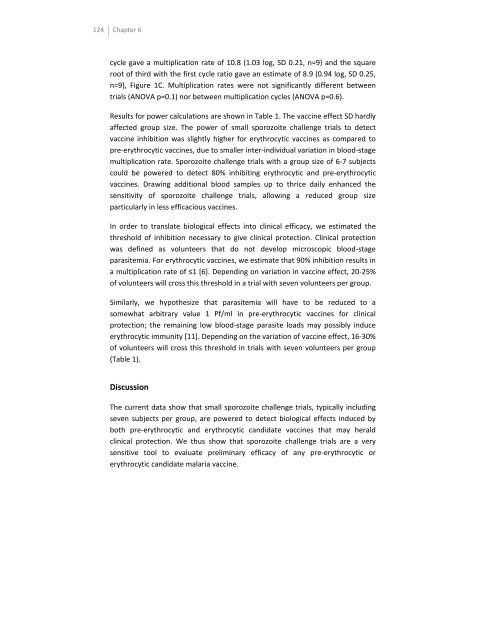Experimental infection and protection against ... - TI Pharma
Experimental infection and protection against ... - TI Pharma
Experimental infection and protection against ... - TI Pharma
Create successful ePaper yourself
Turn your PDF publications into a flip-book with our unique Google optimized e-Paper software.
124 Chapter 6<br />
cycle gave a multiplication rate of 10.8 (1.03 log, SD 0.21, n=9) <strong>and</strong> the square<br />
root of third with the first cycle ratio gave an estimate of 8.9 (0.94 log, SD 0.25,<br />
n=9), Figure 1C. Multiplication rates were not significantly different between<br />
trials (ANOVA p=0.1) nor between multiplication cycles (ANOVA p=0.6).<br />
Results for power calculations are shown in Table 1. The vaccine effect SD hardly<br />
affected group size. The power of small sporozoite challenge trials to detect<br />
vaccine inhibition was slightly higher for erythrocytic vaccines as compared to<br />
pre-erythrocytic vaccines, due to smaller inter-individual variation in blood-stage<br />
multiplication rate. Sporozoite challenge trials with a group size of 6-7 subjects<br />
could be powered to detect 80% inhibiting erythrocytic <strong>and</strong> pre-erythrocytic<br />
vaccines. Drawing additional blood samples up to thrice daily enhanced the<br />
sensitivity of sporozoite challenge trials, allowing a reduced group size<br />
particularly in less efficacious vaccines.<br />
In order to translate biological effects into clinical efficacy, we estimated the<br />
threshold of inhibition necessary to give clinical <strong>protection</strong>. Clinical <strong>protection</strong><br />
was defined as volunteers that do not develop microscopic blood-stage<br />
parasitemia. For erythrocytic vaccines, we estimate that 90% inhibition results in<br />
a multiplication rate of ≤1 [6]. Depending on variation in vaccine effect, 20-25%<br />
of volunteers will cross this threshold in a trial with seven volunteers per group.<br />
Similarly, we hypothesize that parasitemia will have to be reduced to a<br />
somewhat arbitrary value 1 Pf/ml in pre-erythrocytic vaccines for clinical<br />
<strong>protection</strong>; the remaining low blood-stage parasite loads may possibly induce<br />
erythrocytic immunity [11]. Depending on the variation of vaccine effect, 16-30%<br />
of volunteers will cross this threshold in trials with seven volunteers per group<br />
(Table 1).<br />
Discussion<br />
The current data show that small sporozoite challenge trials, typically including<br />
seven subjects per group, are powered to detect biological effects induced by<br />
both pre-erythrocytic <strong>and</strong> erythrocytic c<strong>and</strong>idate vaccines that may herald<br />
clinical <strong>protection</strong>. We thus show that sporozoite challenge trials are a very<br />
sensitive tool to evaluate preliminary efficacy of any pre-erythrocytic or<br />
erythrocytic c<strong>and</strong>idate malaria vaccine.













